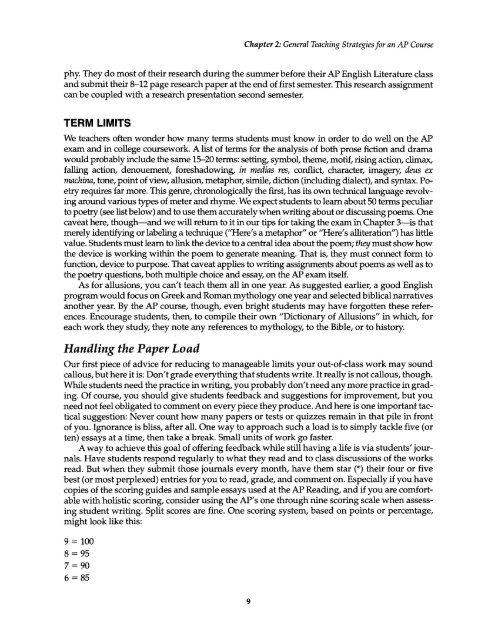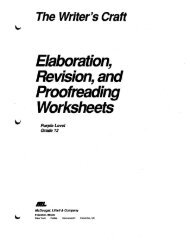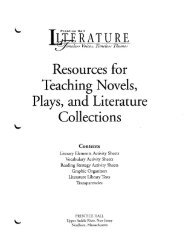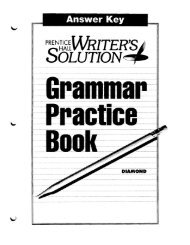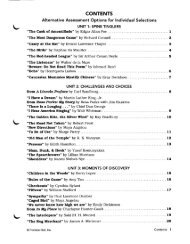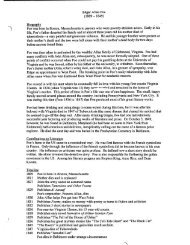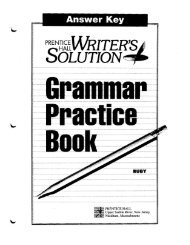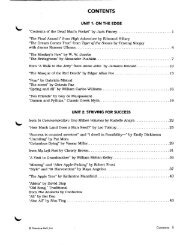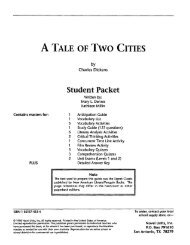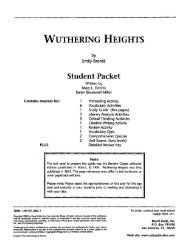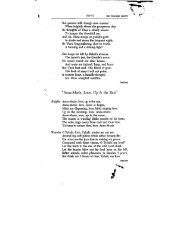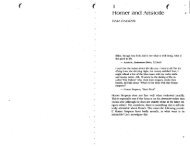English Literature & Composition - PopulationMe.com
English Literature & Composition - PopulationMe.com
English Literature & Composition - PopulationMe.com
You also want an ePaper? Increase the reach of your titles
YUMPU automatically turns print PDFs into web optimized ePapers that Google loves.
Chapter 2: General Teaching Strategies for an AP Course<br />
phy. They do most of their research during the summer before their AP <strong>English</strong> <strong>Literature</strong> class<br />
and submit their 8-12 page research paper at the end of first semester. This research assignment<br />
can be coupled with a research presentation second semester.<br />
TERM LIMITS<br />
We teachers often wonder how many terms students must know in order to do well on the AP<br />
exam and in college coursework. A list of terms for the analysis of both prose fiction and drama<br />
would probably include the same 15-20 terms: settin~ symbol, theme, motif, rising action, climax,<br />
falling action, denouement, foreshadowing, in medias res, conflict, character, imagery, deus ex<br />
machina, tone, point of view, allusion, metaphor, simile, diction (including dialect), and syntax. Poetry<br />
requires far more. This genre, chronologically the first, has its own technical language revolving<br />
around various types of meter and rhyme. We expect students to learn about 50 terms peculiar<br />
to poetry (see list below) and to use them accuratelywhen writing about or discussing poems. One<br />
caveat here, though-and we will return to it in our tips for taking the exam in Chapter 3-is that<br />
merely identifying or labeling a technique ("Here's a metaphor" or "Here's alliteration") has little<br />
value. Students mustlearn to link the device to a central idea about the poem; they must show how<br />
the device is working within the poem to generate meaning. That is, they must connect form to<br />
function, device to purpose. That caveat applies to writing assignments about poems as well as to<br />
the poetry questions, both multiple choice and essay, on the AP exam itself.<br />
As for allusions, you can't teach them all in one year. As suggested earlier, a good <strong>English</strong><br />
program would focus on Greek and Roman mythology one year and selected biblical narratives<br />
another year. By the AP course, though, even bright students may have forgotten these references.<br />
Encourage students, then, to <strong>com</strong>pile their own "Dictionary of Allusions" in which, for<br />
each work they study, they note any references to mythology, to the Bible, or to history.<br />
Handling the Paper Load<br />
Our first piece of advice for reducing to manageable limits your out-of-class work may sound<br />
callous, but here it is: Don't grade everything that students write. Itreally is not callous, though.<br />
While students need the practice in writing, you probably don't need any more practice in grading.<br />
Of course, you should give students feedback and suggestions for improvement, but you<br />
need not feel obligated to <strong>com</strong>ment on every piece they produce. And here is one important tactical<br />
suggestion: Never count how many papers or tests or quizzes remain in that pile in front<br />
of you. Ignorance is bliss, after all. One way to approach such a load is to simply tackle five (or<br />
ten) essays at a time, then take a break. Small units of work go faster.<br />
A way to achieve this goal of offering feedback while still having a life is via students' journals.<br />
Have students respond regularly to what they read and to class discussions of the works<br />
read. But when they submit those journals every month, have them star (*) their four or five<br />
best (or most perplexed) entries for you to read, grade, and <strong>com</strong>ment on. Especially if you have<br />
copies of the scoring guides and sample essays used at the AP Reading, and if you are <strong>com</strong>fortable<br />
with holistic scoring, consider using the AP's one through nine scoring scale when assessing<br />
student writing. Split scores are fine. One scoring system, based on points or percentage,<br />
might look like this:<br />
9 = 100<br />
8 = 95<br />
7 = 90<br />
6 = 85<br />
9


